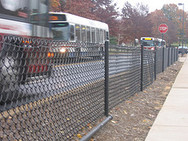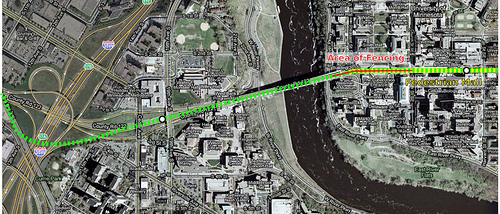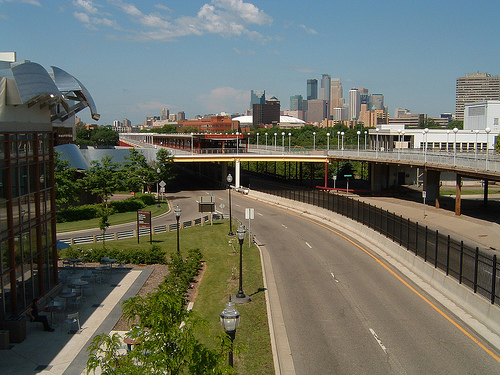UMD fights phantom fences from Purple Line
The University of Maryland and the Maryland Transit Administration remain at odds over the Purple Line. One argument that UMD loves to trot out is that the light rail line will turn campus into a maze of tall fences.
While MTA fiercely denies that they are planning to install fences, the University of Maryland claims evidence to the contrary. Administrators cite the University of Minnesota, where a light rail line connecting Minneapolis and Saint Paul is under construction. Staffers at UMD claim that the light rail line there caused 42-inch-high fences to be erected to keep students off the tracks.
There are several problems with this logic, but the most important is that the fences pre-date the light rail line. In fact, they are being removed as part of the project.
The University of Minnesota is located along the banks of the Mississippi River, close to downtown Minneapolis. Running east-west across campus is Washington Avenue. It’s a major arterial roadway. In fact, leaving downtown Minneapolis it is a full-fledged freeway. It is a depressed, controlled access highway across the “West Bank” part of campus and on part of the “East Bank” campus. East of Church Street, Washington Avenue becomes a surface street with sidewalks and cross traffic.
But on the freeway section of Washington Avenue, the east and westbound lanes are divided by a concrete median barrier topped by 42-inch high iron fences. Those fences have been there for some time. Light rail construction just started at the University of Minnesota this month, so the causation argument fails.
This photo looks east toward the intersection of Church and Washington. Note how the fence ends just beyond the pedestrian overpass. That’s where the freeway becomes a street.
Looking west (from the other side of the street), you can see the Washington Avenue freeway enter the bridge over the Mississippi River. Also note the lack of sidewalks. This is not a pedestrian friendly campus center, it’s a freeway shoulder.
The Central Corridor Light Rail will improve access between the University of Minnesota and both Minneapolis and Saint Paul. As a part of the construction, Washington Avenue will be converted to a transit and pedestrian mall. This will result in wider sidewalks, better access to transit, and a less obtrusive barrier to pedestrians. The light rail project will be removing the fences that currently “divide” campus.
Since UMD brings this up so often, that’s worth repeating. Right now a freeway median with fences divides the campus. With light rail, the freeway will be closed and the fences removed.
Another objection that UMD brings to the table quite often is the idea that traffic signals will be needed to control the flow of pedestrians. They again cite the University of Minnesota. UMD says that the Minnesota light rail is adding pedestrian signals where currently there are none. And they’re right. Currently, there are traffic signals at each intersection with Washington Avenue from Church Street to Walnut Street. All of those signals will remain, because those streets will cross the transit/ped mall. In addition, the LRT line will add two mid-block pedestrian crosswalks with signals where they currently don’t exist.
So, while the University of Maryland uses the fact that new signals are being installed at the University of Minnesota as a negative side of light rail, in reality, these signals are going to increase pedestrian connectivity on campus because they will allow pedestrians to cross where they currently cannot.
All of this information is readily available in the Final Environmental Impact Statement for the Central Corridor LRT project. However, just to be sure that I didn’t misread the document, I contacted the agency building the Central Corridor.
I received a prompt response from Metro Council spokeswoman Laura Baenen confirming two things. The Central Corridor will indeed be removing the fences and will not be putting up new ones. And the project will also add two new signalized pedestrian crossings where they currently do not exist.
But even if these two things were not the case, it would not be appropriate for the University of Maryland to cite fences at the University of Minnesota to make their case. If the Maryland Transit Administration says they’re not installing fences or traffic signals, then the point is moot. Light rail projects are designed differently in different areas. Just because one has fences in one place, it doesn’t mean that every other light rail project will have fences in every place.
Light rail projects co-exist peacefully with pedestrians throughout the United States and around the globe. Fences are not necessary to protect the right-of-way, and neither of the Universities mentioned in this article are going to be home to projects with fences.
Besides, Campus Drive already has fences to keep students off of Campus Drive. Who installed those? Not MTA: The University of Maryland.
Cross-posted at Rethink College Park.




